 |
Scientific nameCecidochares connexa (Macquart) (=Procecidochares connexa (Macquart))
Common nameChromolaena stem gall fly
Taxonomic positionDiptera: Brachycera: Tephritidae
DiagnosisAdult female with orange-yellow head, eyes bright reddish. Thorax black with conspicuous white setae. Abdomen black, posterior margins of first four tergites with white areas, ovipositor subconical and prominent. Wings with black fasciae. Male similar, except abdomen dark brown and apically
broadly rounded.
Images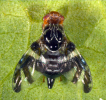
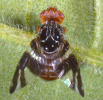
 Adult female Adult male Mating pair 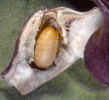
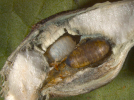 Puparia of the fly inside the gall Puparia of the fly inside the gall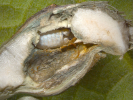 Pupal case inside the gall Pupal case inside the gall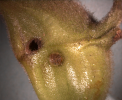
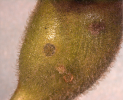 Galls with window Galls with window
DistributionIntroduced in Indonesia, Thailand, Papua New Guinea, East Timor, and India. It was introduced in India in 2002 (Bhumannavar et al., 2004).
Biology and host rangeThe stem gall fly is specific to Siam weed, Chromolaena odorata, which is a major invasive weed. The weed is a native of tropical America and is a serious invasive weed in India, particularly in the northeastern and southern states. In India, host-specificity tests carried out on 75 host plants belonging to 29 families indicated that the gall fly could feed and reproduce only on C.
odorata. Its biology under quarantine has been studied in India (Bhumannavar et al., 2004).
Limited field releases have been carried out in some states such as Assam, Kerala and Karnataka and recoveries made in some places in Karnataka and Kerala, in which the fly has been found promising. Several plant growth parameters were found to be severely affected in gall fly-infested plants. Ormyrus orientalis Walker (Hymenoptera: Ormyridae) has been found to parasitise this species with moderate to high levels of parasitism. Reference
|
